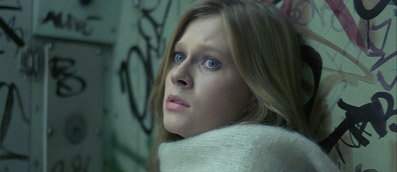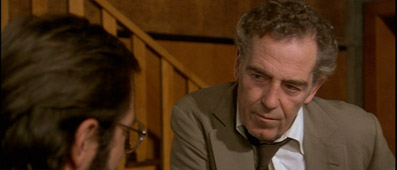|
It's
hard not to love Lucio Fulci just a bit, at least if you're
a horror fan. It's certainly difficult to imagine anyone else
embracing or even tolerating his specific brand of stylish
low budget movie nastiness. And when I say horror fan I
mean the hardcore variety – if you think an enthusiasm for Silence
of the Lambs and The Sixth Sense
alone qualifies you, then I can assure you it does not.
Fulci
made a lot of horror films and never let things like low
budgets, iffy performances or story implausibility get in
the way. Now and then he'd leave his native Italy and nip
over to the America and add the language barrier to this
list of jollies. He actually did rather well by it in the
1979 Zombie Flesh Eaters (released as Zombie
in the US and confusingly known as Zombi 2
elsewhere), one of his most highly regarded and widely seen
works.

And
then there's New York Ripper. You may have
heard of it. Former BBFC censor James Ferman certainly has. His reaction to the film was to demand it be taken
straight to the airport and deported. Had it actually had
a video or cinema release here back in the early 80s, it would definitely have been classed
as a video nasty. If you're too young to have heard that
term then look it up. I'll likely be using it again before the
year is out. Anyway, after Ferman chased it off, it became
a banned film in the UK and didn't resurface until five years ago.
It was finally granted a UK release, but only after cuts
to one sequence had been made, with further cuts ordered
for this DVD release, the details of which you'll find below.
I've not seen the uncut version yet (ridiculous I know,
but there you are), but I can say with some confidence that
this is not just about the violence, but the context in
which it's administered.
New
York Ripper is the sort of spell-it-out title that
saves me having to outline the plot. Oh all right. It's
modern day New York, or modern day for when the film was
made, and there's a killer on the loose. See, told you.
On the case is Lt. Fred Williams, and the only clue he has
is that the killer has the voice of an animal. Creepy,
huh? Unfortunately the animal in question is Donald Duck.
In terms of the story, this actually makes a degree of sense.
Well, eventually it does. That probably won't help you take
him any more seriously – Donald Duck with a sharp knife
is still Donald Duck.
Lt.
Fred is fabulously slow off the mark. Told that he's had
a call from someone who sounds like a duck he muses, "Like
a duck. Where have I heard that before?" while the
audience shouts and throws fruit at the dozy bugger. To help
profile his killer he enlists the expertise of Dr. Davis,
a useless twit given to banal theorising and whose hilariously
crap final psychoanalysis of the killer's state of mind
makes that tagged-on scene at the end of Psycho
play like a model of sincere research.
Fred
aside, it's initially uncertain just who the central characters
are. First up, there's the pretty young cyclist who cops
some verbal from a driver and gets revenge by writing a
rude word on his windscreen. She gets brutally killed. Then
there's Jane, who goes to live sex shows to play with herself
and record the action for her husband's later amusement.
She gets felt up in a bar by a couple of sleazy hoodlums
of Spanish persuasion, then she gets killed too. And
there's Fay, who is approached by an unpleasant fellow on
a deserted subway train and runs straight into the arms
of the killer. But she survives. Aha!
Surprisingly,
all of this works heavily in the film's favour, busying the
plot beyond the expected straight-line route through a series
of bloody murders to the killer's eventual unmasking. A
big but obvious red herring is thrown into the mix, Lt.
Fred's favourite prostitute Kitty is grabbed and tortured
for him to hear over the phone, and the killer's identity,
though not too hard to guess, at least has a half-interesting
story attached to it.

Fulci's
sometimes canny knack for the right camera angle and a nifty
edit keeps things moving at a busy pace, and while we may
not get to know anyone well enough to care too much for
their fate, there's still one genuinely tense scene in which
a tied-up and abused woman has to silently escape her sleeping
captor. And hey, Dr. Davis's pap aside, the ending has class.
But
it's the violence that caused the trouble and for which the film is largely remembered. It's bloody, usually
involves blades and is always inflicted on young women,
some of them naked. Where genre devotees will recognise
the influence of Italian giallo horror, others will see
only misogyny, particularly in the most notorious sequence,
where a naked woman is tied to a bed and sliced up with
a razor blade. It's here that the BBFC have stepped in with
its censorial scissors.
Even
it its reduced form, New York Ripper is
likely to repel the sensitive, but this is a film with a
specific target audience, one that is already familiar with
the unsafe morality of this particular breed of cinematic
horror. And unless you've successfully imported Anchor Bay's
director's cut from over the pond, it's rather nice to have
the chance to see what the fuss was all about, even if we're
still denied access to its full gratuitous brutality.
Having
been refused a certification outright back in 1982, New
York Ripper was finally resubmitted to the BBFC
in 2002. 22 seconds of cuts were ordered, which the BBFC
details thus:
Cuts
required to detailed, close up sight of a woman's stomach,
breast and nipple being cut with a razor blade, in accordance
with BBFC guidelines and policy on sexualised violence,
and in line with the requirements of the Video Recordings
Act 1984. The cuts also take into account current interpretation
of the Obscene Publications Act 1959.
A
further submission to the BBFC was required for this DVD
release, and with rules even tighter on what goes out on
home video, a further 12 seconds of cuts were required,
bring the total to 34 seconds. The BBFC details the reasons as:
Cuts
were required to remove sexualised violence (a naked and
bound woman's stomach and breasts being mutilated with
a razor) in keeping with BBFC Guidelines, Policy and the
Video Recordings Act 1984.
In
the USA, Anchor Bay released a DVD of director's cut of
the film back in 1999, but there's little chance that making it to the UK, given that it would still be subject
to BBFC censorship.
One
question – why no anamorphic print? This is a real shame,
given the quality of the letterboxed 2.35:1 transfer here,
which is sharp, reasonably clean and with good contrast
and colour. Indeed, as letterboxed prints go, this one blows
up rather well. But still...

The
Dolby 2.0 mono track more readily betrays its age, with
a slight background hum and a treble bias to some of the
dialogue and sound effects. It does the job.
The
only one here is the original trailer,
which includes enough of the violence to get the genre fans
interested. There are also trailers for six other upcoming
Shameless releases, which you'll have to manually skip through
if you want to get straight to the movie. They can also
be accessed from the main menu.
The
first of a pair of releases for new UK DVD label Shameless
(the other is Phantom
of Death) establishes the label's intentions
from the off, complete with bright yellow video cases that
will warm the heart of any giallo devotee. That we have
a cut version of here is down to the BBFC and the Video
Recordings Act. That we have it on DVD at all is a plus
for horror fans. Pity about the non-anamorphic transfer,
but other than that it looks better than I was expecting.
|